Items filtered by date: October 2023
What Causes Corns on the Feet?
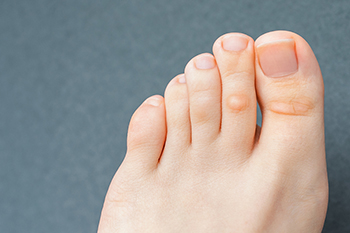
Corns on the feet, while small in size, can cause significant discomfort and annoyance. These thickened, hardened areas of skin typically form in response to repetitive friction or pressure. Corns are the body's way of defending against this constant irritation, creating a protective barrier that may not always be welcome. The primary cause of corns is wearing ill-fitting footwear. Shoes that are too tight, narrow, or have high heels can squeeze the toes and create pressure points, prompting corn development. Similarly, wearing shoes with inadequate arch support can lead to corns on the soles. Other potential culprits can include deformities in the feet, such as bunions or hammertoes, which alter the foot's shape and increase the likelihood of corns. By paying attention to the health and comfort of your feet, you can avoid the persistent nuisance of corns. If you have developed one or more corns on your feet, it is suggested that you speak with a podiatrist who can guide you toward appropriate treatment methods.
Corns can make walking very painful and should be treated immediately. If you have questions regarding your feet and ankles, contact Shaun J. Limon, DPM and Lisa Griffith-Limon, DPM of Limons Foot & Ankle Care. Our doctors will treat your foot and ankle needs.
Corns: What Are They? And How Do You Get Rid of Them?
Corns are thickened areas on the skin that can become painful. They are caused by excessive pressure and friction on the skin. Corns press into the deeper layers of the skin and are usually round in shape.
Ways to Prevent Corns
There are many ways to get rid of painful corns such as:
- Wearing properly fitting shoes that have been measured by a professional
- Wearing shoes that are not sharply pointed or have high heels
- Wearing only shoes that offer support
Treating Corns
Although most corns slowly disappear when the friction or pressure stops, this isn’t always the case. Consult with your podiatrist to determine the best treatment option for your case of corns.
If you have any questions please feel free to contact our office located in Lakewood Ranch, FL . We offer the newest diagnostic and treatment technologies for all your foot and ankle needs.
Causes of Turf Toe
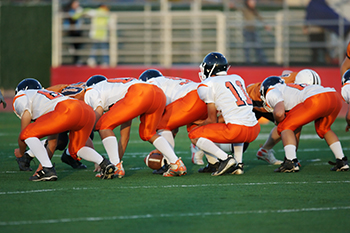
A condition known as turf toe is primarily the result of hyperextending the first joint of the big toe. It is a condition that is caused by jamming the big toe or repeatedly pushing off it forcefully, as in running and jumping. This injury is often seen in athletes or individuals who participate in activities with repetitive, forceful toe hyperextension. Among them are football players, dancers, and gymnasts. Direct trauma to the big toe, such as a sudden impact, collision, or another player falling onto the heel, can lead to turf toe. This places significant stress on the metatarsophalangeal, or MTP, joint. On surfaces with high adhesion, like artificial turf, the shoe may stick while the body is in motion, forcing the toe into hyperextension. This is particularly common in sports like soccer. Wearing shoes that lack proper support and stiffness can contribute to turf toe, especially when participating in activities that require quick stops, starts, and changes in direction. Frequent running and jumping with overly flexible shoes can gradually weaken the structures that support the MTP joint, making it susceptible to injury. Understanding these causes and taking preventive measures can significantly reduce the risk of turf toe. For help in treating a turf toe injury, it is suggested that you make an appointment with a podiatrist.
Toe pain can disrupt your daily activities. If you have any concerns, contact Shaun J. Limon, DPM and Lisa Griffith-Limon, DPM of Limons Foot & Ankle Care. Our doctors can provide the care you need to keep you pain-free and on your feet.
What Causes Toe Pain?
Most severe toe pain is caused due to a sports injury, trauma from dropping something heavy on the toe, or bumping into something rigid. Other problems can develop over time for various reasons.
Toe pain can be caused by one or more ailments. The most common include:
- Trauma
- Sports injury
- Wearing shoes that are too tight
- Arthritis
- Gout
- Corns and calluses
- Hammertoe
- Bunions
- Blisters
- Ingrown toenails
- Sprains
- Fractures (broken bones)
- Dislocations
When to See a Podiatrist
- Severe pain
- Persistent pain that lasts more than a week
- Signs of infection
- Continued swelling
- Pain that prevents walking
Diagnosis
In many cases the cause of toe pain is obvious, but in others, a podiatrist may want to use more advanced methods to determine the problem. These can range from simple visual inspections and sensation tests to X-rays and MRI scans. Prior medical history, family medical history, and any recent physical traumatic events will all be taken into consideration for a proper diagnosis.
Treatment
Treatments for toe pain and injuries vary and may include shoe inserts, padding, taping, medicines, injections, and in some cases, surgery. If you believe that you have broken a toe, please see a podiatrist as soon as possible.
If you have any questions please feel free to contact our office located in Lakewood Ranch, FL . We offer the newest diagnostic tools and technology to treat your foot and ankle needs.
Strategies That May Help to Prevent Toenail Fungus
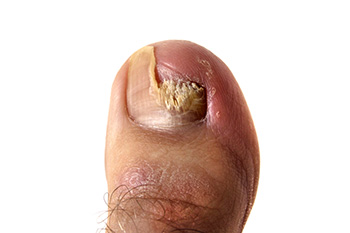
Toenail fungus, medically known as onychomycosis, can be a persistent and unsightly problem. However, staying vigilant and proactive can help you maintain healthy toenails. One of the primary prevention strategies is maintaining good foot hygiene. Regularly wash your feet with soap and water, ensuring to dry them thoroughly, especially between the toes. Keep your toenails trimmed and cut them straight across to prevent debris buildup. Opt for breathable footwear and moisture-wicking socks to reduce the risk of fungal growth in damp environments. If you visit public pools or locker rooms, it is helpful to wear shower shoes that can minimize contact with potentially contaminated surfaces. Additionally, avoid sharing personal items such as nail clippers or shoes with others. Lastly, manage underlying health conditions, as problems like diabetes or weakened immune systems can increase susceptibility to toenail fungus. If you have toenail fungus, it is strongly suggested that you speak with a podiatrist for effective treatment methods and additional prevention strategies.
If left untreated, toenail fungus may spread to other toenails, skin, or even fingernails. If you suspect you have toenail fungus it is important to seek treatment right away. For more information about treatment, contact Shaun J. Limon, DPM and Lisa Griffith-Limon, DPM of Limons Foot & Ankle Care. Our doctors can provide the care you need to keep you pain-free and on your feet.
Symptoms
- Warped or oddly shaped nails
- Yellowish nails
- Loose/separated nail
- Buildup of bits and pieces of nail fragments under the nail
- Brittle, broken, thickened nail
Treatment
If self-care strategies and over-the-counter medications does not help your fungus, your podiatrist may give you a prescription drug instead. Even if you find relief from your toenail fungus symptoms, you may experience a repeat infection in the future.
Prevention
In order to prevent getting toenail fungus in the future, you should always make sure to wash your feet with soap and water. After washing, it is important to dry your feet thoroughly especially in between the toes. When trimming your toenails, be sure to trim straight across instead of in a rounded shape. It is crucial not to cover up discolored nails with nail polish because that will prevent your nail from being able to “breathe”.
In some cases, surgical procedure may be needed to remove the toenail fungus. Consult with your podiatrist about the best treatment options for your case of toenail fungus.
If you have any questions, please feel free to contact our office located in Lakewood Ranch, FL . We offer the newest diagnostic and treatment technologies for all your foot care needs.
How to Find Your Perfect Shoe Size
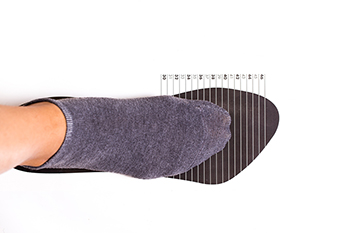
Finding the right shoe size is essential for comfort, foot health, and overall well-being. A poorly fitting shoe can lead to aches, pains, and even long-term problems. Begin by measuring your feet regularly, as their size can change over time. Using a Brannock device is an accurate method of obtaining the right shoe size. While trying on shoes, it is important to know that sizes can vary between brands and styles, so do not solely rely on the number. Pay attention to how the shoe feels. There should be enough room for your toes to wiggle, and the shoe should neither squeeze nor slip off your heel. Consider the shape of your feet, whether you have a high or low arch and any specific needs such as orthotic inserts. Walking around in the shoes can help to ensure they do not cause discomfort or pressure points. Keep in mind that your feet may slightly swell during the day, so it is wise to shop for shoes later in the afternoon. Prioritizing comfort and fit over style can help you to find the perfect shoe size. If you would like additional information about how to determine your correct shoe size, it is suggested that you speak to a podiatrist.
Getting the right shoe size is an important part of proper foot health. Seek the assistance of Shaun J. Limon, DPM and Lisa Griffith-Limon, DPM from Limons Foot & Ankle Care. Our doctors will provide the care you need to keep you pain-free and on your feet.
Getting the Right Shoe Size
There are many people who wear shoes that are the incorrect size, negatively affecting their feet and posture. Selecting the right shoes is not a difficult process, so long as you keep several things in mind when it comes to choosing the right pair.
- When visiting the shoe store, use the tools available to measure your foot.
- Be sure there is ‘wiggle room’. There should be about an inch between your toes and the tip of your shoes.
- Do not always assume you are the same size, as manufacturers run differently.
- Purchase shoes later in the day, as your feet swell as the day progresses.
- If a shoe is not comfortable, it is not suitable. Most shoes can’t be ‘broken in’, and comfort should be the ultimate goal when it comes to choosing the right pair of shoes
As our feet hold our body weight and keep us moving, it is important to treat them right. Picking the right pair of shoes can provide your feet comfort and mobility without pain.
If you have any questions, please feel free to contact our office located in Lakewood Ranch, FL . We offer the newest diagnostic and treatment technologies for all your foot care needs.
Plantar Fibromatosis
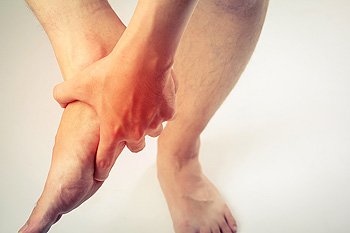
The plantar fascia is a thick fibrous tissue in the foot that helps maintain the arch. Plantar fibromas typically affect the medial and central bands of the plantar fascia. This condition, also known as Ledderhose disease, is rare and is characterized by the formation of nodules on the plantar fascia of the foot. It is more common in middle-aged men and can be associated with other fibrous tissue disorders. These nodules can cause pain and even disability. Diagnosis is primarily clinical, but imaging tests such as an MRI and ultrasound can be helpful. Treatment options include conservative measures and surgical intervention. Symptoms include slow growing nodules on the arch of the foot, which can become painful and affect walking. Physical examination is essential for diagnosis, and imaging can confirm the condition. Conservative treatments include steroid injections, oral medications, radiation therapy, and extracorporeal shock wave therapy. These aim to reduce pain and nodule size. Surgical options may be considered for pain relief, but recurrence is possible. If you are suffering from any sort of foot pain, it is suggested that you make an appointment with a podiatrist for a proper evaluation and individualized treatment.
A plantar fibroma may disrupt your daily activities. If you have any concerns, contact Shaun J. Limon, DPM and Lisa Griffith-Limon, DPM of Limons Foot & Ankle Care. Our doctors can provide the care you need to keep you pain-free and on your feet.
Plantar Fibroma
A plantar fibroma is a fibrous knot in the arch of the foot. It is embedded in the plantar fascia which is a band of tissue that extends from the heel to the toes along the bottom of the foot. There can be multiple plantar fibromas in the feet at the same time. There are no known causes for this condition. If you have a plantar fibroma, there will be a bump in the arch of your foot that cannot be missed. Any associated pain is most often due to a shoe rubbing against the nodule. Non-surgical options, such as steroid injections, physical therapy, and orthotics should be tried first. Surgery is a last resort and is the only thing that will remove a plantar fibroma entirely. Consult with a podiatrist for a proper diagnosis and to determine the treatment regimen that is right for you.
What Causes a Plantar Fibroma?
While there are no specific causes identified, a plantar fibroma can possibly come from genetic predisposition or the formation of scar tissue that forms from healing the tears in the plantar fascia.
What Are the Symptoms of a Plantar Fibroma?
There will be a noticeable lump in the arch of the foot that may or may not cause pain. If pain is felt, it is typically because a shoe is rubbing up against the lump or when walking or standing barefoot.
Treatment and Prevention
A plantar fibroma will not disappear without treatment, but it can get smaller and be a non-issue. If pain persists, a podiatrist examines the foot and when the arch of the foot is pressed, pain can be felt down to the toes. An MRI or biopsy might be performed to help diagnose or evaluate the plantar fibroma. The following non-surgical options are generally enough to reduce the size and pain of these nodules:
- Steroid injections
- Orthotics
- Physical therapy to help apply anti-inflammatory creams on the bump
Surgery is considered if the mass increases in size and the patient continues to feel pain after non-surgical methods are tried.
If you have any questions please feel free to contact our office located in Lakewood Ranch, FL . We offer the newest diagnostic tools and technology to treat your foot and ankle needs.



